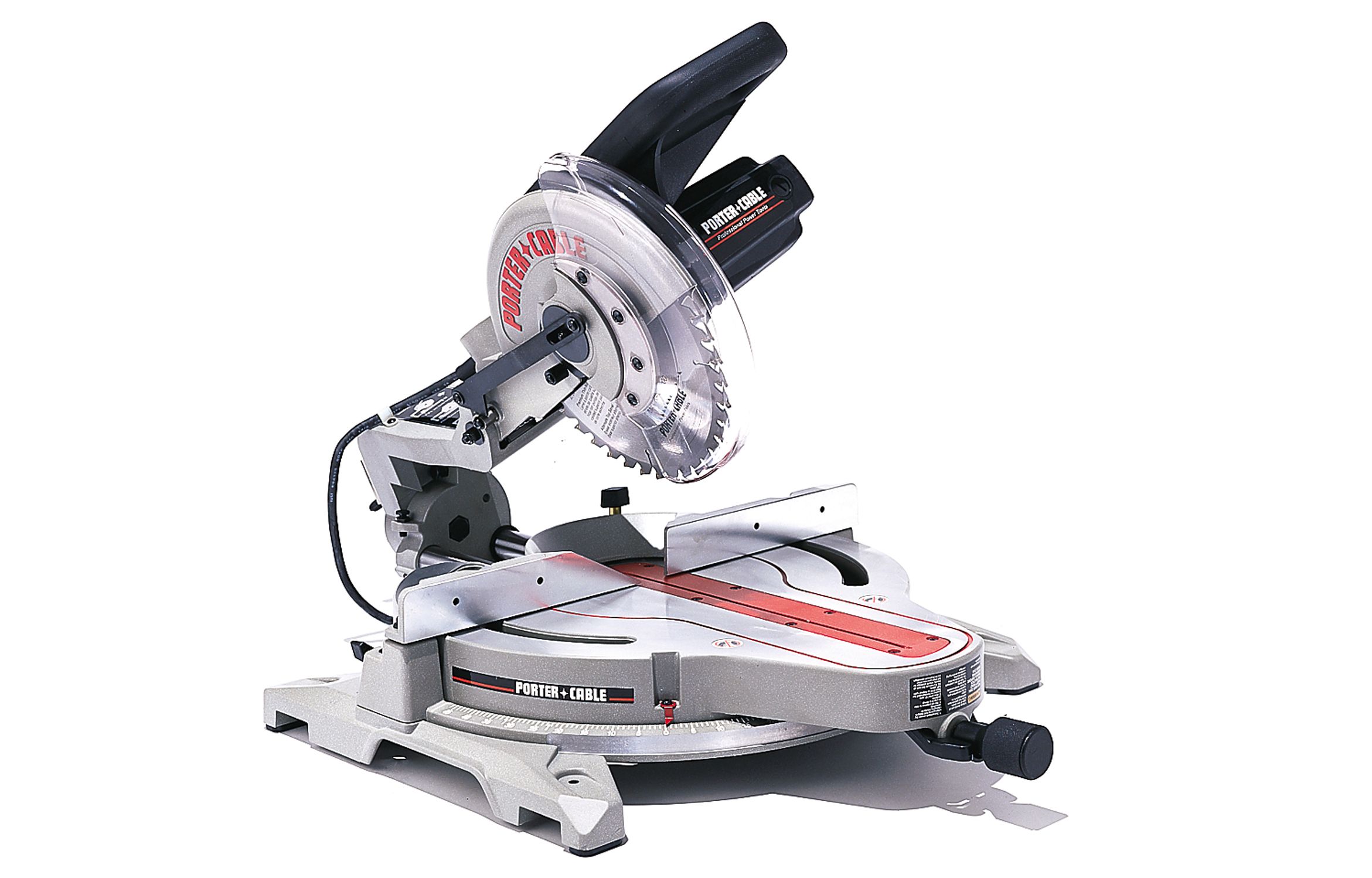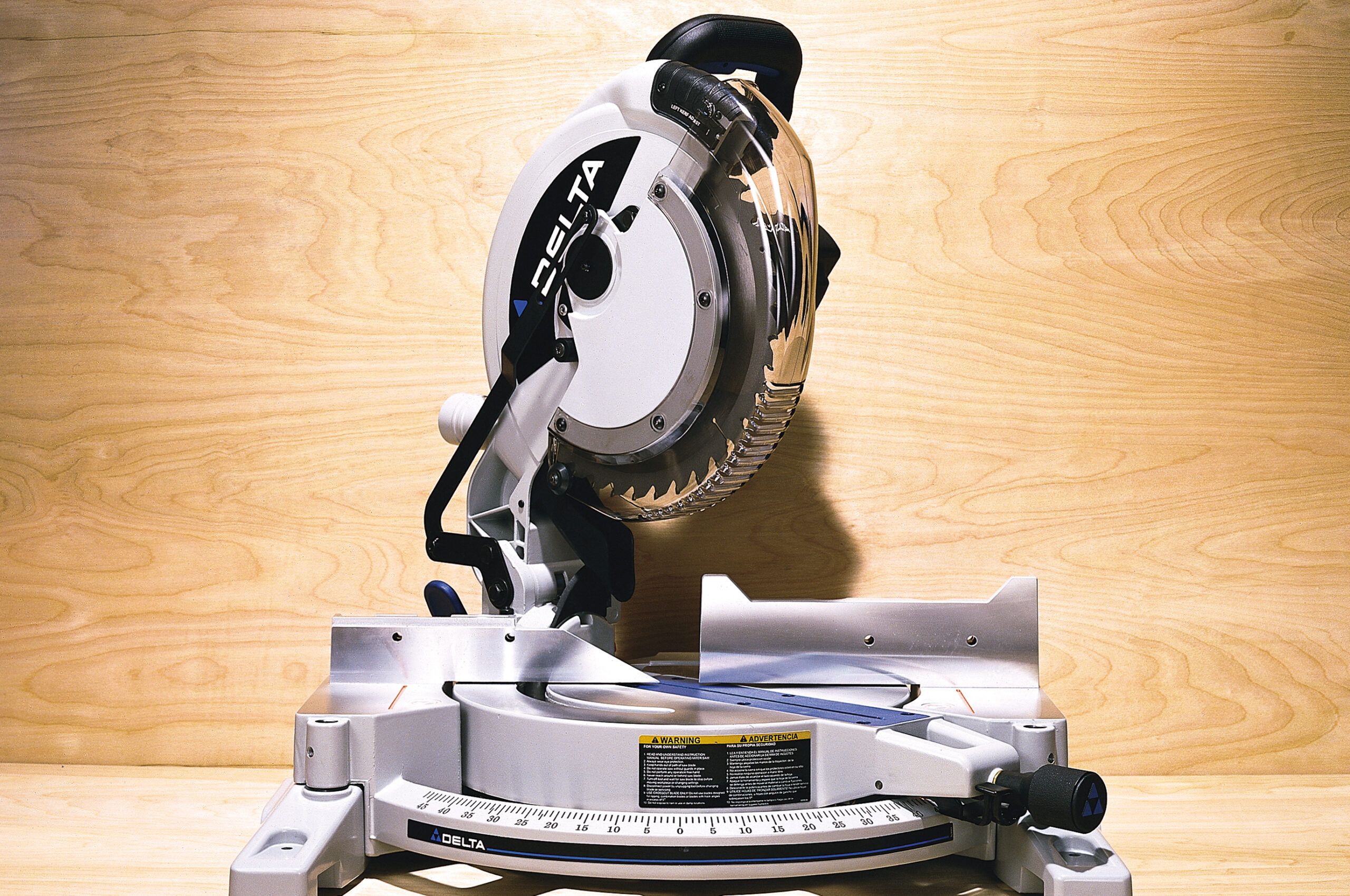Miter saws are known for their precision compared to other power tools. “You can shave off little bits until you get a perfect fit,” says Tom Silva. This level of accuracy, combined with built-in safety features, makes miter saws both efficient and safer than many other power cutting tools. While they excel at making crosscuts and angled cuts, it’s important to understand their limitations and when to use other tools for specific tasks.
Our guide takes you through everything you need to know about miter saws, from the different types to advanced techniques for getting the most out of your tool.

Types of Miter Saws
There are several types of miter saws. Choose the one that works best for your specific project.
Basic Miter Saw
A basic miter saw is the simplest and most affordable option. It’s designed for making straight crosscuts and miter cuts, but doesn’t tilt for bevel cuts.
Pros:
- Solid basic job site saw
- Relatively inexpensive
- Lightweight for easy transport and setup
Cons:
- Can’t cut bevels
- Width and depth of cut are limited to blade reach
Compound Miter Saw
A compound miter saw has the ability to tilt the blade to one side, allowing for bevel cuts in addition to miters and crosscuts. Some models can tilt in both directions.
Pros:
- Makes all basic cuts, including bevels
- More versatile than a basic miter saw
Cons:
- Width and depth of cut are still limited to blade reach
- Single-bevel models require flipping the workpiece for some cuts
Sliding Compound Miter Saw
This type of saw combines the features of a compound miter saw with a sliding arm, significantly increasing the cutting capacity for wider boards.
Pros:
- Makes all basic cuts
- Slide mechanism increases cutting capacity
- Works well for cutting wider stock
Cons:
- More expensive than non-sliding models
- Takes up more space due to the sliding mechanism
Double-Bevel Sliding Compound Miter Saw
A double-bevel sliding compound miter saw, the most versatile option, can tilt in both directions and slide, offering the widest range of cutting options.
Pros:
- Makes all straight, mitered, and beveled cuts
- No need to flip the workpiece for opposing bevels
- Maximum versatility for complex cuts
Cons:
- Most expensive option
- Requires more setup and adjustment for precise cuts
Key Features To Consider When Buying a Miter Saw
Here are the most important factors to consider when shopping for a miter saw.
Blade Size
Miter saw blades typically have diameters of 7.25, 8.5, 10, and 12 inches. Larger blades can cut wider and thicker materials but are also more expensive and require more powerful motors.
Motor Power
The motor’s power, measured in amps, determines how easily the saw can cut through dense or thick materials. Most miter saws range from 10–15 amps, with higher amperage providing more cutting power.
Cutting Capacity
This refers to the maximum width and thickness of material the saw can cut. Sliding models generally offer greater cutting capacity than non-sliding saws of the same blade size. Also, consider the range of angles the saw can cut. Most saws offer miter cuts up to 45 degrees left and right, but some can go up to 90 degrees.
Top Miter Saw Brands and Models
While specific model recommendations can change over time, some brands consistently produce high-quality miter saws. DeWalt, Makita, Bosch, and Milwaukee are known for their durable and precise tools.
When choosing a model, consider your specific needs, budget, and the types of projects you’ll be tackling. It’s often worth investing in a higher-quality saw if you plan to use it frequently, or for precision work.
How To Use a Miter Saw Safely
Safety should always be your top concern when using any power tool, especially one with an exposed blade like a miter saw. Here are some important safety tips:
Essential Safety Gear
- Safety glasses to protect your eyes from flying debris.
- Ear protection, as miter saws can be quite loud.
- Dust mask, especially if you’ll be making a lot of cuts.
Proper Stance and Technique
Silva recommends these tips for safe miter saw operation:
- Take a stable stance, and clear away scraps of wood that could upset your footing.
- With one hand, hold the material tight to the fence and down against the table while working the saw with the other.
- Push the saw blade steadily down into the wood.
- Pull the sliding saw all the way forward before lowering it into the wood, then push to cut. This ensures the saw’s force works with you to press the wood in and down.
- Never pull the blade through the wood.
Common Cuts You Can Make With a Miter Saw
A miter saw can make several types of cuts, each serving different purposes in woodworking projects.
Crosscuts
These are straight 90-degree cuts across the wood grain. They’re the most basic and common cuts made with a miter saw.
Miter Cuts
Miter cuts are angled cuts across the face of the board. They’re commonly used for joining two pieces of wood at an angle, such as in picture frames or baseboards.
Bevel Cuts
Bevel cuts are angled cuts through the board’s thickness. They’re useful for creating sloped edges or for joining boards at angles other than 90 degrees.
Compound Cuts
Compound cuts combine both miter and bevel angles in a single cut at angles other than 90 degrees. These are often used in crown molding and other complex trim work.
Miter Saw Accessories and Add-Ons

Various accessories can enhance your miter saw’s functionality and precision. Here are some popular options,
Miter Saw Stands
A good stand can significantly improve your workflow, especially when working with long pieces of lumber. Most lumber stock is long, which means you need to support the wood’s ends when cutting with a miter saw. Portable stands can be especially handy for job site work.
Dust Collection Systems
Miter saws generate a lot of sawdust. A dust collection system can help keep your work area clean and improve visibility during cuts.
Laser Guides
Many modern miter saws come with built-in laser guides, which project a line onto the wood to show where the blade will cut. This can be particularly helpful for making accurate cuts.
Maintaining Your Miter Saw
Your miter saw will need a little care from time to time to stay functioning properly. Here’s what we recommend.
Cleaning and Lubrication
Regularly clean your saw to remove sawdust and debris. Pay special attention to the pivot points and sliding mechanisms, lubricating them as recommended by the manufacturer.
Blade Replacement
A sharp blade is essential for clean, accurate cuts. Replace your blade when it becomes dull or damaged. When choosing a replacement blade, consider the type of material you’ll be cutting most often.
Advanced Miter Saw Techniques
As you become more comfortable with your miter saw, you can tackle more complex tasks like the following.
Cutting Crown Molding
Due to its angled profile, cutting crown molding can be tricky. When cutting compound miters on crown molding, mark not only the point of the miter (where the wood meets the corner) but also the direction of the cut. This ensures you’re cutting at the correct angle, even if you need to flip the piece.
Making Repeated Cuts
For tasks that require multiple pieces cut to the same length, use a stop block. Secure it with screws or adjustable locking pliers, positioning it slightly above the table surface to allow sawdust to escape. This setup allows you to quickly and accurately cut multiple pieces to the same length.
Miter Saw vs. Other Saws: When To Use Which
While miter saws excel at crosscuts and angled cuts, they’re not perfect for every cutting task. For ripping lumber (cutting along the grain), a table saw or circular saw is more appropriate. You might use a coping saw or jigsaw for more intricate curved cuts.
Troubleshooting Common Miter Saw Issues
Even with proper use and maintenance, you may occasionally encounter issues with your miter saw. Common problems include inaccurate cuts, blade wobble, or motor issues. Most of these can be resolved through proper alignment, tightening loose components, or replacing worn parts. Always read your saw’s manual for specific troubleshooting steps, and don’t hesitate to get professional help for more serious issues.
Our Conclusion
A miter saw is an invaluable tool for professional contractors and DIY enthusiasts. Its ability to make precise, angled cuts quickly and safely makes it great for many woodworking projects, from basic framing to intricate trim work. By understanding the different types of miter saws, their key features, and proper usage techniques, you can get the most out of this versatile tool.

